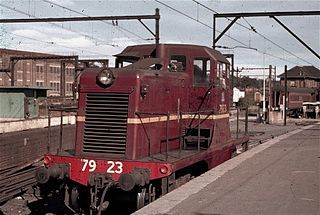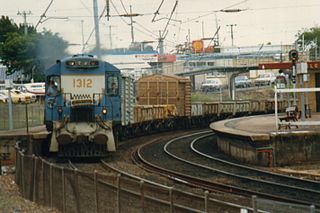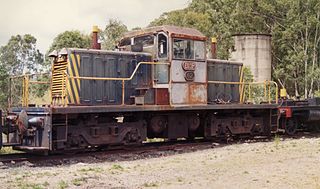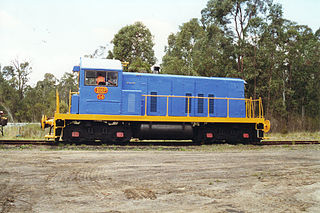Related Research Articles

The 80 class are a class of diesel locomotives built by Comeng for the Public Transport Commission between 1978 and 1983.

The 442 class are a class of diesel locomotives built by AE Goodwin and Comeng, Auburn for the New South Wales Department of Railways between 1970 and 1973.

The T class are a class of diesel locomotives built by Clyde Engineering, Granville for the Victorian Railways between 1955 and 1968.

The GM class are a class of diesel locomotives built by Clyde Engineering, Granville for the Commonwealth Railways in several batches between 1951 and 1967. As of January 2014, some remain in service with Aurizon and Southern Shorthaul Railroad.

The 79 class is a diesel-electric locomotive built by General Electric, Erie, United States for the Department of Railways New South Wales in 1943.

The 1300 class were a class of diesel locomotive built by English Electric, Rocklea for Queensland Rail between 1967 and 1972. They were later sold to AN Tasrail.

The K class are a class of diesel locomotives built by English Electric, Rocklea for the Western Australian Government Railways between 1966 and 1969.

The L Class are a class of diesel locomotives built by Clyde Engineering, Granville and Eagle Farm, and Commonwealth Engineering, Rocklea for the Western Australian Government Railways between 1967 and 1973.

The 830 class are a class of diesel locomotives built by AE Goodwin, Auburn for the South Australian Railways between 1959 and 1966. The New South Wales 48 class and Silverton Rail 48s class are of a very similar design.

The South Australian Railways 930 class was a class of diesel-electric locomotives built for the South Australian Railways between 1955 and 1967 by AE Goodwin, Auburn, New South Wales, the Australian licensee of the American Locomotive Company (Alco). Based on the Alco DL500B World series model, they were fitted with Alco 12-251B four-stroke V12 turbocharged diesel engines that developed 1600 horsepower for traction. The first six of the class had a driving cab at one end only; the remaining 31 locomotives had two. The latter series, up-rated, were the basis of the almost identical New South Wales 44 class, of which 100 were built from 1957.

The 600 class are a class of diesel-electric locomotives manufactured by AE Goodwin, Auburn for the South Australian Railways between 1965 and 1970.

The Goldsworthy railway, owned and operated by BHP, is a private rail network in the Pilbara region of Western Australia built to carry iron ore. It is one of two railway lines BHP operates in the Pilbara, the other being the Mount Newman railway.

The Whyalla Steelworks is a fully integrated steelworks and the only manufacturer of rail in Australia. Iron ore is mined in the Middleback Range to feed the steelworks, resulting in the distribution of finished steel products of over 90 different grades. It occupies a 1,000 ha site on the shore of False Bay, Spencer Gulf and is the largest employer in Whyalla, South Australia.

The 500 class were a class of South Australian Railways diesel shunter locomotives built at Islington Railway Workshops between 1964 and 1969.

The BHP Newcastle 37 class were a class of diesel locomotives built by A Goninan & Co, Broadmeadow for the BHP's, Newcastle Steelworks between 1960 and 1983.

The BHP Newcastle 32 class were a class of diesel locomotives built by A Goninan & Co, Broadmeadow for the BHP, Newcastle Steelworks between 1954 and 1956.
The BHP Whyalla DE class are a class of diesel locomotives built by Clyde Engineering, Granville for BHP between 1956 and 1965.
The D9 class were a class of diesel locomotives built by English Electric, Rocklea for Australian Iron & Steel's, Port Kembla steelworks between 1956 and 1960.
The D35 class are a class of diesel locomotives built by English Electric, Rocklea for Australian Iron & Steel's, Port Kembla steelworks between 1971 and 1975.
The BHP Whyalla Tramway is a 1067 mm gauge heavy-haul railway, 112 kilometres long, on the Eyre Peninsula in South Australia. It runs from haematite mines at Iron Monarch, Iron Baron and Iron Duke in the Middleback Range, about 50 kilometres west of Whyalla, to company steelworks at the coastal city of Whyalla. Opened in 1901, it was built by, and until 2000 operated by, the Broken Hill Proprietary Company (BHP). As of 2021 it was owned by Liberty House Group and operated on its behalf by rail operator One Rail Australia, which was sold in 2022 to Aurizon.
References
- ↑ Oberg, Leon (1984). Locomotives of Australia 1850s – 1980s. Frenchs Forest: Reed Books. pp. 242–243. ISBN 0-730100-05-7.
- ↑ BHP / Onesteel / Arrium Whyalla Diesel Locomotives www.minnipasiding.com.au
- BHP Tramways Centenary History David Griffiths Mile End Railway Museum
- BHP Locomotives David Griffiths Railmac Publications
- Locomotives of Australia By Leon Oberg